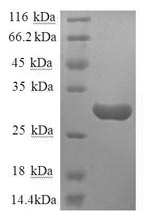Amino acids 1-29 form the expressed segment for recombinant Human TACR1. The theoretical molecular weight of the TACR1 protein is 30.1 kDa. Expression of this TACR1 protein is conducted in e.coli. The TACR1 coding gene included the N-terminal GST tag, which simplifies the detection and purification processes of the recombinant TACR1 protein in following stages of expression and purification.
The substance P receptor is officially known as the Tachykinin receptor 1 (TACR1) or neurokinin-1 receptor (NK1R). This receptor is a G protein-coupled receptor that binds specifically to substance P, a neuropeptide involved in neurotransmission, inflammation, and pain signaling. TACR1 is primarily expressed in the central and peripheral nervous systems and plays a crucial role in mediating the effects of substance P. Upon binding of substance P to TACR1, various intracellular signaling pathways are activated, leading to neurogenic inflammation, vasodilation, and modulation of pain perception. The TACR1 receptor is implicated in numerous physiological and pathological processes, making it a significant target for research in areas such as neuroscience, pain biology, and immunology. Understanding TACR1 function is crucial for developing therapeutic interventions related to pain management and inflammatory disorders.




